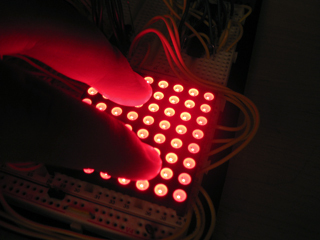If you’re a long-time Hackaday reader like we are, you’ll certainly remember a rash of projects from around ten years ago that all (mis-)used an LED as a light sensor. The idea wasn’t new, but somehow it made the rounds and insinuated itself into our collective minds. Around the same time, a cryptographic cipher with an exceptionally small memory footprint was also showing up in hacker projects: TEA (Tiny Encryption Algorithm).
This old project by [Marcin Bojanczyk], [Chris Danis], and [Brian Rogan] combines both the LED-as-light-sensor meme and TEA to make a door-entry keyfob that works over visible light. And they do so using almost nothing — a few LEDs and just over 2Kb of code. It’s pretty sweet.
Which brings us to the question: where are they (LED-sensors and TEA) now?
 LED-as-light-sensor was just cool. We certainly loved the idea back in 2006. But [Forrest Mims] had been using the phenomenon for decades back then. It certainly makes sense when you’re trying to squeeze as much as possible out of as little as possible, or when budget is a main concern and you just can’t afford an extra photodiode.
LED-as-light-sensor was just cool. We certainly loved the idea back in 2006. But [Forrest Mims] had been using the phenomenon for decades back then. It certainly makes sense when you’re trying to squeeze as much as possible out of as little as possible, or when budget is a main concern and you just can’t afford an extra photodiode.
But our own experience with LEDs as light sensors is that the results are extremely variable across different LEDs. Code that works with water-clear red LEDs might not work with the ones that come in red-tinted plastic, for instance. Is that why they went extinct?
 Similarly, the TEA family of ciphers showed up in a bunch of projects around this time, from the badge for the HOPE conference in 2010 to a widely used RFM12B radio library. There are a couple of attacks on XXTEA, but they only affect reduced-round versions of the cipher, and rely on a tremendous amount of intercepted data — more than we’d see in a home-automation network over years.
Similarly, the TEA family of ciphers showed up in a bunch of projects around this time, from the badge for the HOPE conference in 2010 to a widely used RFM12B radio library. There are a couple of attacks on XXTEA, but they only affect reduced-round versions of the cipher, and rely on a tremendous amount of intercepted data — more than we’d see in a home-automation network over years.
Over the last five years or so, there’s been a lot more Internet of Things, which means using standard Internet-style encryption methods (AES and so on) that are widespread on non-memory-constrained computers. Is that what happened to XXTEA?
Anyway, we got tipped off to a project that combined a few of our favorite (old) ideas in one, so we thought that we’d share. Thanks [Blue Smoke] for the walk down memory lane. Any of you out there keeping the flame(s) alive? Have you used sensing LEDs or XXTEA? Are those projects still going, or do you have any future projects planned with these tricks still up your sleeve? Let us know in the comments below.













